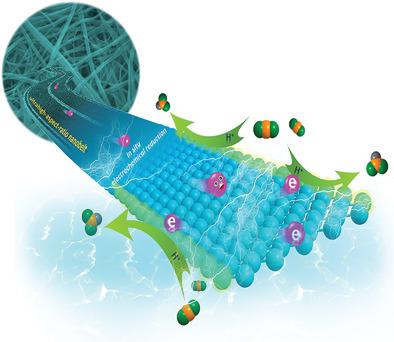当前位置:
X-MOL 学术
›
Adv. Funct. Mater.
›
论文详情
Our official English website, www.x-mol.net, welcomes your
feedback! (Note: you will need to create a separate account there.)
Reconstruction of Ultrahigh-Aspect-Ratio Crystalline Bismuth–Organic Hybrid Nanobelts for Selective Electrocatalytic CO2 Reduction to Formate
Advanced Functional Materials ( IF 18.5 ) Pub Date : 2022-05-08 , DOI: 10.1002/adfm.202201125 Guang Zeng 1, 2 , Yingchun He 1, 3 , Dong‐Dong Ma 1 , Shiwen Luo 4 , Shenghua Zhou 1, 3 , Changsheng Cao 1 , Xiaofang Li 1 , Xin‐Tao Wu 1, 5 , Hong‐Gang Liao 4 , Qi‐Long Zhu 1, 3, 5
Advanced Functional Materials ( IF 18.5 ) Pub Date : 2022-05-08 , DOI: 10.1002/adfm.202201125 Guang Zeng 1, 2 , Yingchun He 1, 3 , Dong‐Dong Ma 1 , Shiwen Luo 4 , Shenghua Zhou 1, 3 , Changsheng Cao 1 , Xiaofang Li 1 , Xin‐Tao Wu 1, 5 , Hong‐Gang Liao 4 , Qi‐Long Zhu 1, 3, 5
Affiliation

|
The morphology and active site engineering of electrocatalysts is an efficient strategy to improve the intrinsic activity and selectivity of electrocatalytic CO2 reduction. Here the ultralong and thin Bi nanobelts (Bi-NBs) are fabricated, which feature a high edge-to-facet ratio and high-degree connectivity is inherited from the ultrahigh-aspect-ratio crystalline bismuth−organic hybrid nanobelts, through a cathodically in situ reconstruction process. The unique nanostructure of Bi-NBs leads to a significantly enhanced performance for electrocatalytic CO2 reduction with a near-unity formate selectivity and high formate partial current density, which is far superior to those of the discrete Bi counterparts with low edge-to-facet ratios. Notably, Bi-NBs perform ultrahigh formate selectivity over a broad potential window with a high current density reaching 400 mA cm−2 for formate production in a flow cell. Moreover, it is ultrastable to continuous electrolysis for nearly 23 h at 200 mA cm−2 without compromising the selectivity. Based on calculations, the enhanced performance is closely related to the high edge-to-facet ratio of Bi-NBs, since the rich edge sites are conducive to the stabilization of the key *OCHO intermediate for formate production. In addition, the ultralong and interconnected Bi-NBs provide “expressways” for electron transfer during CO2 electroreduction, further contributing to the improved performance.
中文翻译:

超高纵横比晶体铋-有机杂化纳米带的重建用于选择性电催化 CO2 还原生成甲酸盐
电催化剂的形态和活性位点工程是提高电催化CO 2还原的固有活性和选择性的有效策略。在这里制造了超长和薄的Bi纳米带(Bi-NBs),它具有高边棱比和高度连接性,继承自超高纵横比晶体铋-有机杂化纳米带,通过阴极在原位重建过程。Bi-NBs 的独特纳米结构显着提高了电催化 CO 2的性能具有接近统一的甲酸盐选择性和高甲酸盐部分电流密度的还原,这远远优于具有低边棱比的离散 Bi 对应物。值得注意的是,Bi-NB 在宽电位窗口内具有超高的甲酸盐选择性,高电流密度达到 400 mA cm -2,用于在流通池中生产甲酸盐。此外,它在 200 mA cm -2下对连续电解近 23 小时是超稳定的在不影响选择性的情况下。根据计算,增强的性能与 Bi-NB 的高边面比密切相关,因为丰富的边缘位点有利于稳定生产甲酸盐的关键 *OCHO 中间体。此外,超长且相互连接的 Bi-NB 为 CO 2电还原过程中的电子转移提供了“高速公路”,进一步有助于提高性能。
更新日期:2022-05-08
中文翻译:

超高纵横比晶体铋-有机杂化纳米带的重建用于选择性电催化 CO2 还原生成甲酸盐
电催化剂的形态和活性位点工程是提高电催化CO 2还原的固有活性和选择性的有效策略。在这里制造了超长和薄的Bi纳米带(Bi-NBs),它具有高边棱比和高度连接性,继承自超高纵横比晶体铋-有机杂化纳米带,通过阴极在原位重建过程。Bi-NBs 的独特纳米结构显着提高了电催化 CO 2的性能具有接近统一的甲酸盐选择性和高甲酸盐部分电流密度的还原,这远远优于具有低边棱比的离散 Bi 对应物。值得注意的是,Bi-NB 在宽电位窗口内具有超高的甲酸盐选择性,高电流密度达到 400 mA cm -2,用于在流通池中生产甲酸盐。此外,它在 200 mA cm -2下对连续电解近 23 小时是超稳定的在不影响选择性的情况下。根据计算,增强的性能与 Bi-NB 的高边面比密切相关,因为丰富的边缘位点有利于稳定生产甲酸盐的关键 *OCHO 中间体。此外,超长且相互连接的 Bi-NB 为 CO 2电还原过程中的电子转移提供了“高速公路”,进一步有助于提高性能。











































 京公网安备 11010802027423号
京公网安备 11010802027423号